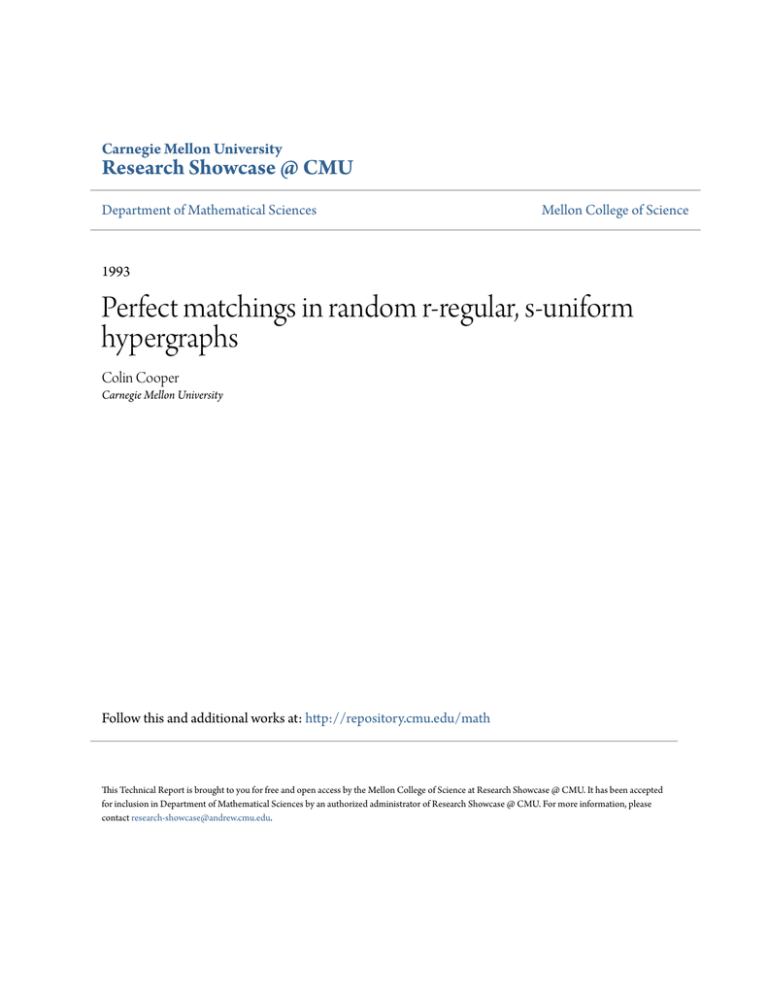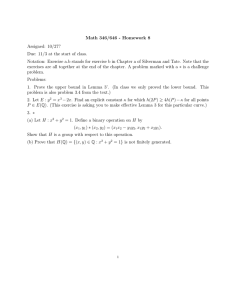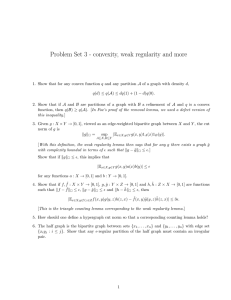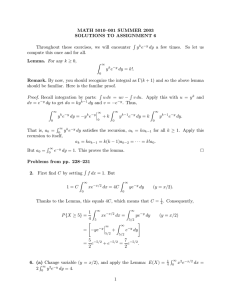Perfect matchings in random r-regular, s
advertisement

Carnegie Mellon University
Research Showcase @ CMU
Department of Mathematical Sciences
Mellon College of Science
1993
Perfect matchings in random r-regular, s-uniform
hypergraphs
Colin Cooper
Carnegie Mellon University
Follow this and additional works at: http://repository.cmu.edu/math
This Technical Report is brought to you for free and open access by the Mellon College of Science at Research Showcase @ CMU. It has been accepted
for inclusion in Department of Mathematical Sciences by an authorized administrator of Research Showcase @ CMU. For more information, please
contact research-showcase@andrew.cmu.edu.
NOTICE WARNING CONCERNING COPYRIGHT RESTRICTIONS:
The copyright law of the United States (title 17, U.S. Code) governs the making
of photocopies or other reproductions of copyrighted material. Any copying of this
document without permission of its author may be prohibited by law.
P E R F E C T M A T C H I N G S IN R A N D O M
s-UNIFORM
HYPERGRAPHS
by
Colin Cooper
School of Mathematical Sciences
University of North London
and
Alan Frieze
Michael Molloy
Bruce Reed
Department of Mathematics
Carnegie Mellon University
Pittsburgh, PA 15213
Research Report No. 93-157
October 1993
510.6
C28R
93-157
r-REGULAR,
Perfect matchings in random i—regular,
5—uniform hypergraphs.
Colin Cooper*
Alan Frieze*
Bruce Reed§
Michael Molloy*
September 8, 1993
1
Introduction
Let E = {X\,X2, • • • ,Xm} where the X,- C V for 1 < i < m are distinct.
The hypergraph G = (V, JE7) is said to be s-uniform if |X,| = 5 for 1 < t < m.
Thus, for example, a 2—uniform hypergraph is a graph. A set of edges
M = {Xi : i G / } is a perfect matching if
(i) izjL j G / implies Xt 0 Xj = 0, and
(ii)
*School of Mathematical Sciences, University of North London. Research done while
visiting Carnegie Mellon University
^Department of Mathematics, Carnegie Mellon University. Supported in part by NSF
grants CCR9024935 and CCR9225008.
^Department of Mathematics, Carnegie Mellon University. Supported in part by NSF
grant CCR9225008.
^ Department of Mathematics, Carnegie Mellon University
' 1
One of the most interesting and difficult problems in probabilistic combinatorics can be described as follows: suppose that the X{ are chosen independently at random from the ('^'), s-subsets of V. For what value of ra, the
number of edges, is it likely that G will contain a perfect matching? When
5 = 2, this was solved by Erdos and Renyi [4]. For s > 3 w e only have the
fairly loose results of Schmidt and Shamir [9].
Putting \V\ = sn it is reasonable to make the following:
CONJECTURE. Assume s is a positive integer constant and m = n(log n+
logs + cn) then
0
lim P r ( G has a perfect matching ) =
Cn
e
e~ ~
Cn
1
Cn
—* —oo,
-> c,
—> oo.
The right-hand side of the above expression is simply the limiting probability
t h a t U£Li Xi = V. The case s = 2 was dealt with in [4].
A related and special case of the problem is that of packing vertex disjoint
copies of a fixed graph H in a random graph G. The existence of perfect
packings was solved completely by Luczak and Rucinski [5] for the case when
H is a tree. Less precise results were obtained by Rucinski [8] for arbitrary
graphs.
For v 6 V, let du{v) = \{i : v G X t } | be the degree of v. H is r—regular if
dH(v)
= r for all v G V. Let now V = [sn], where [k] = { 1 , 2 , . . . , k} for all
positive integers k. Let Q = Q(n,r,s)
= {G = (V,E)
: G is r - r e g u l a r and
5—uniform }. Let G = Gn,r,s be chosen uniformly at random from Q. In this
paper we prove
Theorem 1 Suppose r, s are fixed positive integers, then
Yim^ Pr(Gn<fV, has a perfect matching ) = <
r
where
logr
(r-l)lQgfe)
+ 1.
D
[Note that or is always non-integral and so this result is best possible.]
Next let f(s) = min{r : 5 < or}. Thus f(s) gives the threshold in terms of
degree for a s-uniform hypergraph to almost surely have a perfect matching.
We have computed the first few values of f(s) and they are given in Table
1. For s large f(s) is approximately e3"1.
s
2 3 4 5 6
10
9
7 8
3 7 19 52 146 401 1094 2979 8126
Table 1:
To prove the theorem, we make use of a remarkable new approach due to
Robinson and Wormald [6] and [7]. Although new to probabilistic combinatorics, we will see that their method is in fact an Analysis of Variance
technique with a clever partition of the probability space based on the number of small cycles.
Since the case s = 2 is well known, we will assume that s > 3 from now on.
To prove our theorem, we need a suitable probabilistic model for generating
G(n,r, s). We will use a natural generalisation of the Configuration Models
of Bender and Canfield [2] or Bollobas [3], which we now describe.
2
Configurations
Let Wv = {v} x [r] for v G V = [sn] and W = Uv€v Ww. Each Wv should
be regarded as a block of r fractional edges for each v € V, thus generalising
the concept of half-edges arising from the use of configurations in the context
of graphs. In this context, a configuration is a partition of W into m = rn
subsets of size s. Let ft = ft(n, r, 5) be the set of all such configurations, and
let F = F(n, r, 5) be chosen randomly from fi.
For x = (v,t) e VF we let ^(z) = v. If F € ft and S 6 F we let V(S) =
(ar) : a: G 5}. We define the multigraph 7 ( F ) = (V, {V(5) : 5 € F}).
F is simple if S G F implies 1^(5)1 = 5 and distinct 51,52 G F have
V(5i) 7^ V(52). Thus 7(F) is s-uniform if and only if F is simple. A routine
calculation shows that
Jirn Pr(35i,5 2 € F with V(SX) = V(S2)) = 0.
The main properties we need are
(A) each G G Q arises from precisely (r\)sn simple configurations F.
(B) Jiim Pr(F is simple ) = e-(s-\)(r-i)/2 ( s e e Lemma 2 below).
A perfect matching of F is then a set {5t- : i G /} C F such that
(ii) ij £l,i^
j implies V(S{) n V(Sj) = 0, and
(iii) U € / V(Si) = V.
Thus if F is simple it has a perfect matching if and only if 7(F) has a perfect
matching. Furthermore, Theorem 1 will follow immediately from (A) and
(B) above and
Theorem 2
lim P r ( F has a perfect matching ) = < n
F J
n-+oo v
*}
y 1
r
s
< aT
D
3
Outline Proof of Theorem 2
We use the notation a « /? to mean a = (1 + o(l))/3 where the o(l) term
tends to zero as n tends to infinity. All subsequent inequalities are only
claimed to hold for sufficiently large n.
Suppose that F is chosen randomly from f2. Let Z{F) denote the number of
perfect matchings in F. We will prove the following lemma in Section 4.
Lemma 1
E(z)
Notice that the first (easy) part of Theorem 1 now follows immediately since
the righthand side of (1) tends to zero exponentially fast when s > ar.
To apply the Analysis of Variance technique, we have to decide on a partition
of ft. We proceed analogously to Robinson and Wormald. For the moment
let 6, x be arbitrarily large fixed positive integers.
We now define a fc—cycle of F for integer k > 1.
k = 1: 5 G F is a 1-cycle if 1^(5)1 < s.
k = 2: Si, 5 2 G F form a 2-cycle if \V(SX) n V(S 2 )| > 2.
k > 3: Si, S 2 , . . . , Sfc G F form afc—cycleif there exist distinct t>i, ^ 2 , . . . , vjb G
V such that Vi e V(S{) D V(S{+i) for 1 < i < fc, (5 fc+i = 5i).
Observe that F is simple if and only if it has no 1-cycles and yields no
repeated edges.
Next let Cfc denote the number of k—cycles of F for k > 1. For c =
(ci,c 2 ,...,c 6 ) e AT6, where N = {0,1,2,...}, let ftc = {F G ft : Ck =
Cjk,l < A: < 6}. Let
Afc=
((5 - l)(r - l))fc
2k
*
Lemma 2 Let c 6e /ixed, t/ien
Now define
S(z) = {c € Nb: \ck - Afc| < xAj /3 ,1 < k < b},
and
n = U nc.
Let
W = P r ( F 6 H).
For c e iV6 let
Ec = E(Z | F e ftc)
and
Vc = Var(Z | F e Qc).
Then we have
"EV ^ 2 \
M2J\ ZJ I
V
/
=
/»-7Tr»T/K r i"T"V ^7 ^-TT^jtS^.
Z?2
V^
>
2--^
ceA^
v
6
^
Z—/
b
^
C
/o\
(O)
V /
ceN
The following two lemmas contain the most important observations. Lemma
3 shows that for most groups, the group mean is large and Lemma 4 shows
that most of the variance can be explained by the variance between groups.
Lemma 3 For all sufficiently large x (a) W < e~ax for some absolute constant a > 0. (b) c e S(x) implies
Ec >e
for some absolute constants /?, 7 > 0.
Lemma 4 If x is sufficiently large then
where 7 is as in Lemma 3
O
Hence we have from (2) and (3),
(4)
where 6 = {be~^x + (jz\)b) y ^ i j . The rest is an application of the Chebycheff inequality. Define the random variable Z(F) by
Z(F) = Ec, if F € Hc.
Then for any t > 0
< 6E(Z)2/t\
(5)
where the last inequality follows from (4).
Now put t = e~(^+7a?)E(Z)/2 where /?, 7 are from Lemma 3. Applying Lemma
3 we obtain
Pr(Z^O)
> Pr(Z > e
> Pr(|Z-Z| <iA
> 1 - A6e2^x)
-W
Hence, using Lemma 3
lim Pr(Z = 0) < Ube2^x + 4 ( ^ Y e^+^A J£=l.
(6)
This is true for all 6, x and so limn^oo Pr(Z = 0) must in fact be zero, proving
Theorem 2, (putting b = x2 and x arbitrarily large makes the right-hand side
of (6) arbitrarily small).
8
4
Moments
First of all let
(sm)\
v
™
'
m!(a!)»»
denote the number of ways of partitioning [sm] into m s-sets. Then for any
fc>o,
Pr(F contains k given s-tples)
=
(s\)k(rn)k
sk /
/ \
(srn)
,ri
n
,
if k is fixed
We can then compute
7\
{rn)
on using Stirling's Formula. Here ifis(n)rsn counts the number of distinct
possible perfect matchings.
We can assume from now on that s < ar. Next we have
E(Z2) = B(Z)f: fj)^(n-fc)(r-l)^-fcVJ(rn-2n+fc)M((r-l)n). (7)
Explanation: we choose a fixed perfect matching Mo and compute the
probability that F contains a perfect matching M given it contains Mo.
Summing over M$ accounts for E(Z). The parameter k denotes the number
of s-tuples common to M and MQ. (?) counts the number of ways of choosing
these. There are ^3{n — k)(r — l)5(n~fc) possible completions. The remaining
terms give the probability of M given Mo-
Let Uk denote the summand in the right-hand side of (7). Then for 1 < k < n
u>k+i
~^T
n —k
=
y j s(rn — 2 n + k) + i
s
(k + l){r-l)
fJi
sn - sk - i
, ,
}
"
We first eliminate k < en and n-k <en from consideration, where e = e(ry s)
is small.
From (8), when k < n/(10r) we have Wfc+i/^fc > 5. Hence
ln/(20r)j
^
5 n/(20r)
li
Ln/(10r)j,
and so the first n/(20r) terms can be "ignored". Similarly, if for some e > 0
we have k > n(l — 6) then
uw
ttfc
(r - 1 - e)-*
-
(r-1)^-2
(
•
.
W
Also wn = 1 and since Z) ujt > E(Z) we can also ignore k > n(l — r~s). Thus
on applying Stirling's Formula and putting k — n{\ + x)/r we get
X
h x)(r - 1 - x)n V( 1 + x>
E
10
The range of summation for x is {—1 + ~ : n/(20r) < k < n(\ — Vs)}. Thus
— l < x < r — 1. Note that the term with x « 0 corresponding to k = [ n / r J
is approximately one and so we can eliminate any terms of order o{n~l).
We continue with the terms with \x\ < 1. Here we can expand (1 + x)l+x
and see that they contribute
r
x\<i A/2TT(1 + x)(r
xk
(n (°°
— 1 — x)n
I
r
K K
\k=2
\
n / r(r — 5)
2(r (
f
(r - s)n 2
2(r - 1 ) ^
We will subsequently eliminate the terms with x > 1 as being insignificant
and so from (10) and (12),
/ exp
- 1) •/-
(r-s)
2r-1
2\
2
J
as claimed. (Note that in going from the first line to the second line, the
factor r disappears as x changes in steps of r/n.)
11
Now to deal with x > 1. Returning to (10) we bound from above its righthand side, for x > 1, by
n/r
2 5 1
^
g
**-*
\ylT
since a; < r — 1 in the summation.
Now consider
where C ==
[~'
r _[
4>\x) = 2^x - log(l + x)
4T(x) = 2C-r^~
1 +X
Observe first that 2£ < log 2 for all s > 3 and ar > s. Also (j> will be concave
and decreasing until x == ~ — 1 and convex from then on. Also for fixed s
and x > 1, <j)(x) decreases with r. Our strategy is now as follows: taking
r = f(s) (see Table 1) we let e = 1/7 in (9) and put xs = | r - 1. We then
verify that
1
y,^.
>1
for r > f(s)
(14)
and
^,/(,)(^) < -.0001 .
12
(15)
Then in the range x e [l,xs] we can use (13) and (15) and in the range
[xSJr — 1] we can use (9) and (14) to show that the contribution of x > 1 is
negligible.
We leave the detailed verification of (14) and (15) to the reader. ((14) is
trivial, as is (f>sj^(l) < —.0001 . The remaining inequality is a bit close for
small 5, but nevertheless true. For large s, f(s) « e8"1 is a good approximation. Also, for s > 4 we can take e = 1/5 and xs = | r — 1 which makes
things easier.)
5
Cycles
First for k > 2,
- 1))*
2k
Explanation: n n accounts for choosing the v\, V2,..., Vk. (k —1)1/2 counts
the cyclic orderings. (r(r — l)) fc counts the choices of points in the blocks
WVi. (*™£) approximates the choices of the remaining k(s — 2) points. Then
we have the probability that the k chosen s-tuples are in F.
When k = 2,
E
s
\)2(rnf
^«(7)(H ™ 2 )i
_
(r-l) 2 (5-l) 2
13
and when k = 1,
, x
fr\ ( srn \ s\rn
E(Ci)
« sn[\[
J
v u
\2J \s - 2) 77(srn)
(srr s
^
2
Thus E(Cfc) = Ajb, for fixed k > 1. Routine calculations can strengthen this
to show that Ck is asymptotically Poisson with this parameter and that in
fact Ci, C 2 , . . . , Cfe are asymptotically independent. This proves Lemma 2.
6
Proof of Lemma 4
Let Mo be some fixed perfect matching . Then
I
c
l A/CF
ku
E(Z)Pr(F e »c | f 3 MQ)
Let Et, t = 0 , 1 , . . . &o = L^/2j denote the expected number of fc-cycles which
contain t s-tuples from M o . Then EQ = ((s - l)(r - 2))k/(2k) and for t > 1
14
sn
f ( — I) X*^"1
\
Explanation: consider the first term inside [ ]'s. Choose t s-tuples T from
Mo and cyclically order them ( ( " ) ^ i ^ ) - Choose ordered pairs of elements
of tuples to connect with non-Mo tuples ((s(s — 1))*). For each such point
choose an element from the same block to go in a non-Mo tuple ((r — I) 2 ').
Choose #1,0:2, • • • ,%t > 1 where x\ + x<i + • • • xt = k — t. There will be
X{ non-Mo tuples between the i'th and (i+l)'th Mo tuple (rT^T 1 ))- ^ o w
consider the third term [ ]. We choose k — 2< members U of V and order
them ((fc!^J(fc — 2i)M. They are to be placed in s-tuples which will then
be put between the tuples in T. Choose ordered pairs from each WU}u G U
(((r — l)(r — 2))A:"~2'). Then choose the remaining (s — 2){k — t) points for the
non-Mo tuples ( « (**jljj /
)*^
e m
^ d l e term [ ] is simply the conditional
probability that the chosen tuples are in F.
Thus
where
(r-2)'Now
feu * - i ; " hk-A
t)
«
15
I
h
+
vi £ i
3
1+
X
i-/•+!.
Thus, putting /i*. = E(Cjt | Mo) we see that
_
((5 - l)(r - l))fc
2fc
=
At 1 +
(r -
Of course, further calculations will show that, given F D Mo, the Ck are
asymptotically independently Poisson with means /i*.. Hence, from (16),
Ec «
(17)
So,
Cfc!
(18)
16
We need to estimate
First put
where a*,/?* > —773- when x is sufficiently large.
From Alon and Spencer [1], p239 we obtain
,
(20)
and
I
If a:Aj/3 > 4O7 then x\lk/3
1/3V
~".r i-"/v—"it
\ -W2
//
> 4O7 for A: = 1,2,..., b and then the right-hand
side of (20) is at most e"~4rr for k = 1,2,..., b.
On the other hand to make the right-hand side of (21) less than e~ 4rc we
need to make
;/3
I67/AP,
17
(22)
where
y
Now when y < 1 we have </>(y) > y/3 and making x > 967 handles those k
for which 487/A*/3 < 1. The set of k for which 487/Aj /3 > 1 depends only
on 7 (i.e. is finite) and we can clearly increase x to make (22) true for all of
these.
Hence, for x sufficiently large,
TTCEI >
E(Z)2(1 - be-^x) TT exp ( ^ 7 ^ 1 •
fc=i
ces(x)
Also
exp
f(aM\
—II—f =
exp
/
i
Thus, from (23), with
E
TcBf > (l
ib=l
r —s
This completes the proof of Lemma 4.
18
I
Xk
)
(23)
7
Proof of Lemma 3
First we quote a lemma from [6].
L e m m a 5 Let 771,7/2? ••• he given. Suppose that 771 > 0 and that for some
c > 1, rji+i/rji > c for all i > 1. Then uniformly over x > 1,
t
t = l *=ifc-(l+y,-) * ' e
where yi = 0:77," '
and CQ = min{77i , 77/ }/4.
(a) Putting 77,- = A,- satisfies the conditions of Lemma 5 with c = r — 1. Now
6
« E E
for some constant a, independent of x.
(b) Applying (17) we obtain
>
ABX,
where
19
and
= n (i-TrrivE)
ku ^AA
odd \
v
n
l
) /
i+piu
k even \
v
l
•
) /
Now
6
_
<
'
Xk
Afc
,
Afc
/r-sN 1 / 4
Vr-lJ '
Now
.2/3
> exp < —
"S(r-lV-lJ"
The sum in the exponential term is convergent and so B is bounded below
by a positive absolute constant.
References
[1] N.Alon and J.H.Spencer, The Probabilistic Method, John Wiley and
Sons, New York 1992.
[2] E.A.Bender and E.R.Canfield, The asymptotic number of labelled
graphs with given degree sequences, Journal of Combinatorial Theory,
Series A, 24 (1978) 296-307.
20
0 1 2004
D137S 7D1M
[3] B.Bollobas, A probabilistic proof of an asymptotic formula for the number of labelled regular graphs, European Journal on Combinatorics, 1
(1980) 311-316.
[4] P.Erdos and A.Renyi, On the existence of a factor of degree one of a
connected random graph, Acta Math. Acad. Sci. Hungar. 17 (1966) 359368.
[5] Luczak and A.Ruciriski, Tree matchings in random graph processes,
SIAM Journal on Discrete Mathematics 4 (1991) 107-120.
[6] R.W.Robinson and N.C.Wormald, Almost all cubic graphs are Hamiltonian, Random Structures and Algorithms 3 (1992) 117-126.
[7] R.W.Robinson and N.C.Wormald, Almost all regular graphs are Hamiltonian, Random Structures and Algorithms to appear.
[8] A.Rucinski, Matching and covering the vertices of a random graph by
copies of a given graph, Discrete Mathematics 105 (1992) 185-197.
[9] J.Schmidt and E.Shamir, A threshold for perfect matchings in random
d-pure hypergraphs, Discrete mathematics 45 (1983) 287-295.
21





